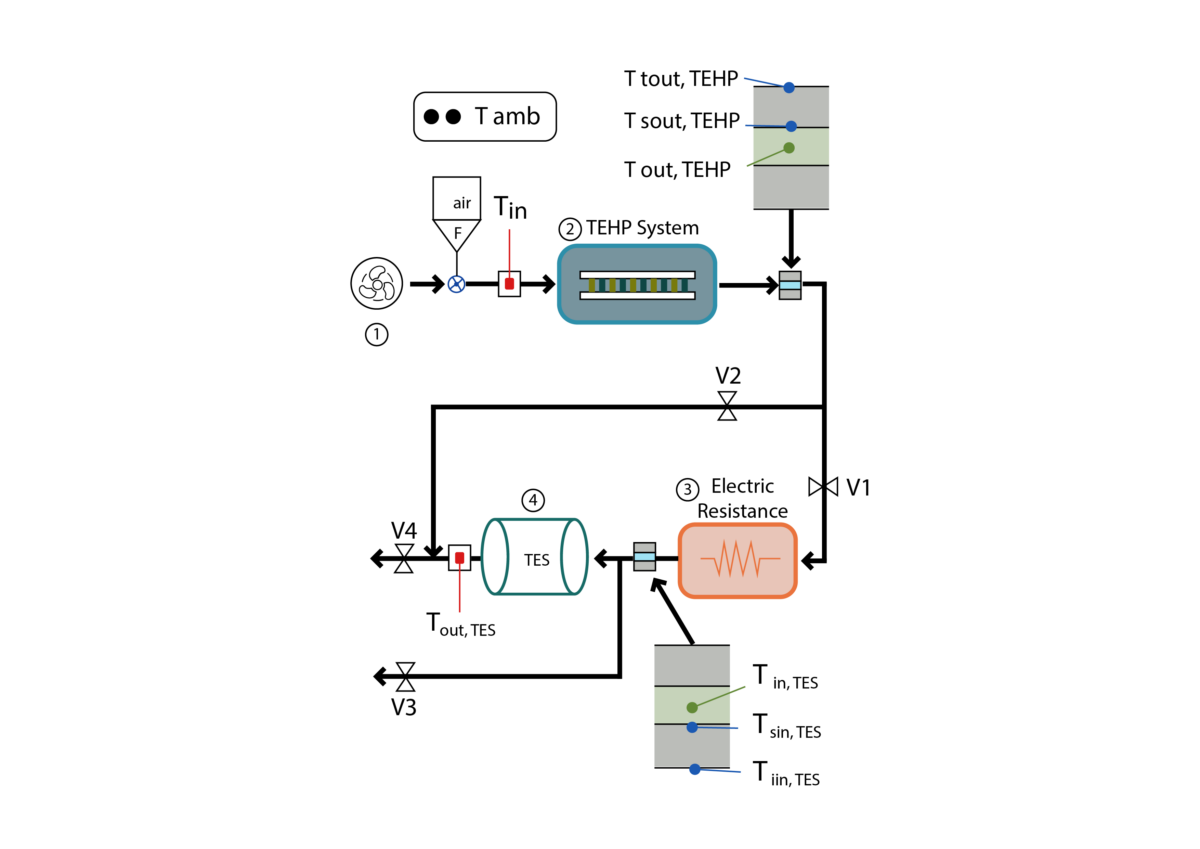Researchers from Spain have designed a novel thermal energy storage (TES) system that utilizes a thermoelectric heat pump (TEHP) as a power-to-heat technology to reach elevated temperatures in charging the storage system itself.
“The analysis focuses on assessing the coefficient of performance (COP) and heating capacity by varying the voltage supply and the airflow rate,” the scientists explained, noting that the TEHP is used as an alternative to variable conductance heat pipes (VCHPs).
The novel design includes four main components, namely a thermoelectric heat pump system, an electric resistance, and a TES cycle that relies on an open cycle with air as a heat transfer fluid. The fan is positioned at the cycle's air inlet, and the pushed air is then heated by the TEHP, which uses thermoelectric modules (TEMs) with complementing electric resistance.
“TEMs are commonly formed by two ceramic plates and several thermocouples formed by n- and p-semiconductor junctions, connected thermally in parallel and electrically in series,” the academics said. “When a current is supplied, heat is pumped from the cold sink to the hot sink by the Peltier effect.”
The thermoelectric part of the system is constructed of six TEHP blocks. The first three use a one-stage thermoelectric heat pump (OTEHP) configuration, each using a TEM with one heat exchanger on each side. The following three TEHP blocks comprise two-stage thermoelectric heat pumps (TTEHP) with a pyramidal configuration.
“The design of this intermediate heat exchanger utilizes a highly efficient system comprised of four heat pipe tubes with water as working fluid,” added the researchers. “The transfer of heat from the first stage to the second stage occurs through these tubes by means of phase change of water.”
The researchers also built a system prototype and tested 45 scenarios with different voltages in the resistor, storage inlet temperature, and airflow rates. The voltages were 4 V, 6 V, 8 V, or 10 V; the inlet temperatures were 120 C, 160 C, or 200 C; and the airflow rates were 13 m3/hour, 18 m3/hour, or 23 m3/hour.
“With the highest studied airflow rate (23 m3/h), 655.5 W of heat can be generated with a COP of 1.35, elevating the airflow temperature from the ambient temperature to 113.1 C,” the group concluded. “The integration of the developed TEHP system into the charging process of a thermal energy storage system based on electrical resistances increases the energy conversion efficiency by 15% and 30% for energy storage temperatures between 120 C and 200 C.”
The academics also found the proposed system configuration may achieve an overall efficiency of 112.6% at 135 C.
The system was presented in the paper “Enhancement of the Power-to-Heat Energy Conversion Process of a Thermal Energy Storage Cycle through the use of a Thermoelectric Heat Pump,” published in Applied Thermal Engineering. The research team was formed by scientists from the Public University of Navarre, the National Renewable Energy Centre of Spain, and the Industry Association of Navarra.
Looking forward, they said they want to understand the system's behavior under varying cold source temperatures and explore the use of different heating fluids, including the integration of phase change materials (PCMs).
This content is protected by copyright and may not be reused. If you want to cooperate with us and would like to reuse some of our content, please contact: editors@pv-magazine.com.



3 comments
By submitting this form you agree to pv magazine using your data for the purposes of publishing your comment.
Your personal data will only be disclosed or otherwise transmitted to third parties for the purposes of spam filtering or if this is necessary for technical maintenance of the website. Any other transfer to third parties will not take place unless this is justified on the basis of applicable data protection regulations or if pv magazine is legally obliged to do so.
You may revoke this consent at any time with effect for the future, in which case your personal data will be deleted immediately. Otherwise, your data will be deleted if pv magazine has processed your request or the purpose of data storage is fulfilled.
Further information on data privacy can be found in our Data Protection Policy.